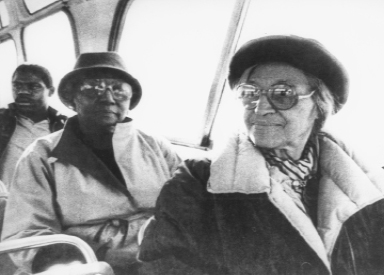Foreword
I was too young to be a Freedom Rider, but I well remember when they arrived in Montgomery. My parents, Johnnie and Arlam Carr Sr., had been active in the Montgomery black community long before the Montgomery Bus Boycott. Mama, in fact, was a childhood friend of Rosa Parks, and it was at Mama’s urging that Mrs. Parks became active with the NAACP in the 1940s.
So when the Freedom Rides began, there was excitement and anticipation in our house. We all knew how important the riders’ challenge to segregation really was. After the rioting by the white mob at the Greyhound bus station on Saturday, May 21, 1961, Mama insisted on going to the First Baptist Church on Ripley Street for the mass meeting called in response.
When white rabble-rousers began rioting outside the church, too, Mama was among the people who were trapped and had to spend the night inside the church while federal marshals and the National Guard tried to restore order outside. Meanwhile, Dr. Martin Luther King was in the church basement on the phone to U.S. Attorney General Robert Kennedy asking for protection.
These events, as we now know, played a pivotal role in breaking down Jim Crow segregation and also helped push Kennedy and his brother, President John F. Kennedy, toward a more vigorous position with respect to civil rights. Locally, the principled courage of the freedom riders, contrasted with the lawless response of the white mobs, helped change the political climate in Montgomery and some white moderate voices emerged on the side of peaceful desegregation.
Mama eventually became president of the Montgomery Improvement Association — Dr. King was its first president — and in the 1980s she and the MIA helped in the crusade to keep the Greyhound bus station from being torn down at the time the annex to the federal courthouse was being built on the adjacent property. Mama and the MIA, Judge Myron Thompson, the Alabama Historical Commission, and Congressman John Lewis were among those who believed that because of what had happened there, the Greyhound bus station should be preserved as a reminder of the historical significance of the Freedom Rides.
Mama did not live to see the new Freedom Rides Museum that has now opened in the old bus station, but she would have been proud to see what has been accomplished in its first phase and what may be added as the future plans come to fruition
She knew that what the freedom riders did in 1961 was brave and necessary, and she welcomed the changes that came to interstate transportation as a result.
I am delighted to help introduce this brief guidebook to the events, places, and people of the Freedom Rides. This book gives only a summary history of the Freedom Rides, but it focuses on the events that took place in Alabama.
I believe it is important that we remember not only what happened in Montgomery, but why the Riders came here, and what happened as a result of their coming. The story of the Freedom Rides is well known now in a general sense, but the details of Jim Crow laws, the particular moment when the Freedom Riders decided to challenge them, and the amazing story of the events that ensued — all of this history is not well understood by the public and deserves to be. That is why this guide, and the museum in Montgomery that it accompanies, is such a useful introduction.
Arlam Carr Jr. was the named plaintiff in the 1964 lawsuit that desegregated the public schools in Montgomery, Alabama, and became one of the first black graduates of Sidney Lanier High School. He attended the University of Texas at El Paso and has worked in television news production for going on four decades.

Rosa Parks, right, and her friend Johnnie Carr, on a ceremonial anniversary ride on a Montgomery city bus, 1975.